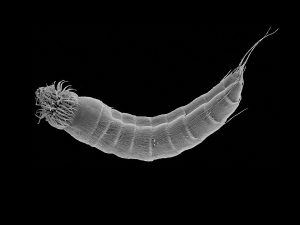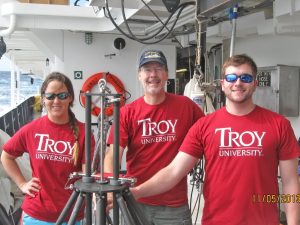Study Describes Two New “Mud Dragon” Species Discovered in Gulf of Mexico
– March 3, 2015
Scientists from Troy University and the University of Copenhagen, who are studying potential oil spill impacts on seafloor-dwelling marine life, examined microscopic invertebrates that live in the sediment (meiofauna).
They identified about twenty-two different kinorhynchs, worm-like animals commonly called mud dragons, including several new to science. They characterized two of these new species and published their findings in the May 2014 edition of Frontiers in Marine Science: Two new species of Echinoderes (Kinorhyncha: Cyclorhagida) from the Gulf of Mexico.
After the Deepwater Horizon oil spill, the Gulf of Mexico Research Initiative funded a continuation of an extensive Gulf meiofauna sampling that started in 2007. Field collections continued through 2014, resulting in hundreds of samples and providing a unique opportunity for detailed community studies.
Mud dragons are spiny invertebrates with an external skeleton that live in sea sediment. Studies suggest that they are a food source for larger marine invertebrates, such as shrimp, and for fish. However, classification data on these species are scarce, leaving much to be learned about their distribution ranges and habitat preferences. This study is the first in a series of publications that characterize existing and newly-discovered mud dragon species collected on the Gulf continental shelf. These researchers provide detailed species descriptions, identifying distinguishing physical features.
The two newly-discovered species fall under order Cyclorhagida, family Echinoderidae, and genus Echinoderes. The first species that researchers described is Echinoderes augustae and the second is Echinoderes skipperae. Most E. augustae and E. skipperae were distributed from Texas to Florida on the continental shelf or near the upper slope. Researchers found some species at deeper sites, and they found that the two species co-occurred near the Mississippi River Delta. These findings suggest that neither species is confined to shallower shelf waters and that continuous populations of both species likely exist along the shelf and its slope.
This study revealed that the Gulf of Mexico continental shelf hosts diverse, yet undescribed, benthic invertebrate populations. Study authors Martin Sørensen and Stephen Landers described the contributions of their findings, “Through our analysis of meiofauna diversity and species distribution, the animals may be able to tell us something about community change as the spill becomes more distant.” They anticipate that their research will support continued ecosystem health assessments, “Future studies can take advantage of this newly-discovered biodiversity to assess environmental changes at various locations in the Gulf, including the shoreline, shelf, and deep sea sites.”
This study’s authors are Martin V. Sørensen and Stephen C. Landers.
************
This research was made possible in part by a grant from the Gulf of Mexico Research Initiative (GoMRI) to Troy University for the project titled Analysis of Continental Shelf Meiofauna in the Northern Gulf of Mexico: Effects of the Deepwater Horizon Oil Spill Investigated during a Long Term Community Study (2007 – Present).
The Gulf of Mexico Research Initiative (GoMRI) is a 10-year independent research program established to study the effect, and the potential associated impact, of hydrocarbon releases on the environment and public health, as well as to develop improved spill mitigation, oil detection, characterization and remediation technologies. An independent and academic 20-member Research Board makes the funding and research direction decisions to ensure the intellectual quality, effectiveness and academic independence of the GoMRI research. All research data, findings and publications will be made publicly available. The program was established through a $500 million financial commitment from BP. For more information, visit https://gulfresearchinitiative.org/.
© Copyright 2010- 2017 Gulf of Mexico Research Initiative (GoMRI) – All Rights Reserved. Redistribution is encouraged with acknowledgement to the Gulf of Mexico Research Initiative (GoMRI). Please credit images and/or videos as done in each article. Questions? Contact web-content editor Nilde “Maggie” Dannreuther, Northern Gulf Institute, Mississippi State University (maggied@ngi.msstate.edu).







